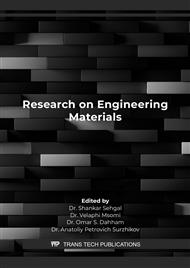[1]
P. Beardmore, C. Johnson, The potential for composites in structural automotive applications, composite science and technology 26 (4) (1986) 251-281; Elsevier Science Ltd.
DOI: 10.1016/0266-3538(86)90002-3
Google Scholar
[2]
X. Sun, RH. Zhang, W Meng, R. Zhang, K. Li, T. Peng, Primary resonance analysis and vibration suppression for the harmonically excited non-linear suspension system using a pair of symmetric viscoelastic buffers, nonlinear dynamics, 4 (2018) 1-23.
DOI: 10.1007/s11071-018-4421-9
Google Scholar
[3]
S. Ebrahim, N. Vadatazad, G Liaghat, Crashworthiness efficiency optimization for two-directional functional-graded foam-filled tubes under axial crashing impacts, Int. Journal of crashworthiness, 22 (3), (2017) 307-321, Taylor & Francis.
DOI: 10.1080/13588265.2016.1258959
Google Scholar
[4]
G. Zhu, G. Sun, H. Yu, S. Li, Q. Li, Energy absorption of metal, composite and metal composite hybrid structures under oblique crushing loading, Int. Journal of Mechanical science;.
DOI: 10.1016/j.ijmecsci.2017.11.017
Google Scholar
[5]
T. Weirzbicki, W. Abramowicz, On the crushing mechanism of thin-walled structures. Journal of applied mechanics, 50 (4), (1983) 727-734.
DOI: 10.1115/1.3167137
Google Scholar
[6]
Abramowicz, W and Jones, N. Dynamic progressive buckling of circular and square tubes, Int. Journal of Impact Engineering, 4 (1986) 243-270.
DOI: 10.1016/0734-743x(86)90017-5
Google Scholar
[7]
C. Baykasoglu, M. Cetin, Energy absorption of circular aluminum tubes with functional-graded thickness under axial impact loading, International Journal of Crashworthiness, 20: 1 (2015) 95-106. Taylor and Francis.
DOI: 10.1080/13588265.2014.982269
Google Scholar
[8]
A. Baroutaji, A, M. Sajjia, A. Olabi, On the crashworthiness performance of thin-walled energy absorbers: Recent advances and future developments, \thin-walled Structures:.
DOI: 10.1016/j.tws.2017.05.018
Google Scholar
[9]
Marzbanrad Javad, Mehdikhanlo Mehdi and Saeedi Pour Ashkan, An energy absorption comparison of square, circular, and elliptical steel and aluminum tubes under impact loading. Turkish Journal Of Engineering and Environmental Science, 33 (2009) 159-166,.
Google Scholar
[10]
A. Ghamarian, H. Zarrei, Crashworthiness investigation of conical and cylindrical end-capped tubes under quasi-static crash loading. Int. Journal of Crashworthiness, Taylor & Francis, 17(11); (2012) 19-28.
DOI: 10.1080/13588265.2011.623025
Google Scholar
[11]
D. Hu, Y. Wang, B. Song, Y. Wang, Energy absorption characteristics of a foam-filled tri-tube under axial quasi-static loading experiment and numerical simulation, Int. Journal of Crashworthiness.
DOI: 10.1080/13588265.2017.1331494
Google Scholar
[12]
A. Adeniyi, D. Onifade, J. Ighalo, A. Adeoye, A Review of coir-fiber reinforced polymer composites, Composite Part B: 176, 107305, Elsevier Science Ltd. (2019).
DOI: 10.1016/j.compositesb.2019.107305
Google Scholar
[13]
X. Nguyen, S. Hou, T. Liu, X. Han, A potential natural energy absorption material-coconut mesocarp: Part A: Experimental investigation on Mechanical Properties. Int. J of Mechanical Science. doi: /10.1016/j.ijmecsci.2016.07.017. (2016).
DOI: 10.1016/j.ijmecsci.2016.07.017
Google Scholar
[14]
A. Ghamarian, S. Azarakhsh, Axial crushing analysis of polyurethane foam-filled combined thin-walled structures: experimental and numerical analysis, Int. Journal of crashworthiness,.
DOI: 10.1080/13588265.2018.1506604
Google Scholar
[15]
El-Dahshan El-Sayed, Proton-proton and proton-antiproton differential elastic cross sections modeling at high and ultra-high energies using a hybrid computing paradigm. Turkish Journal of Physics, 41:426-435,.
DOI: 10.3906/fiz-1704-9
Google Scholar
[16]
A. Karthikeyan, K. Balamurugan, Effect of alkali treatment and fiber length on impact behavior of coin fiber reinforcement epoxy composite, Journal of Scientific & Industrial Research, Vol. 71, 627-631. (2012).
Google Scholar
[17]
M. Jawaid, M. Thariq, N. Saba, Mechanical and physical testing of bio-composites, fiber-reinforced composite and hybrid composites wood herd publishing, Elsevier, 43-57. (2019).
DOI: 10.1016/b978-0-08-102292-4.00001-1
Google Scholar



